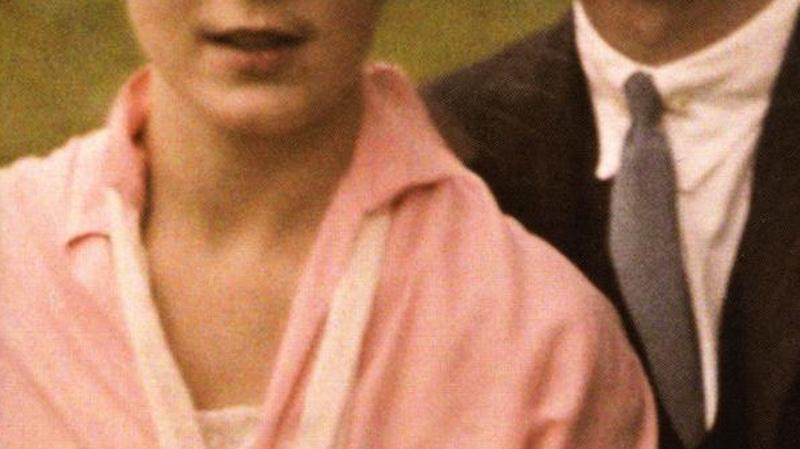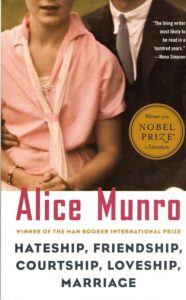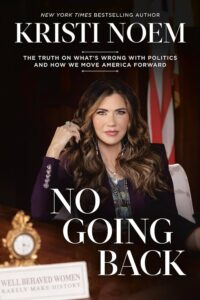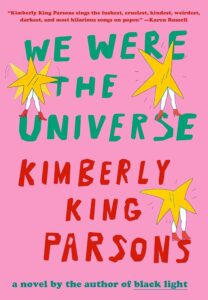
Our F5 tornado of fantastic reviews this week includes Michiko Kakutani on Alice Munro’s Hateship, Friendship, Courtship, Loveship, Marriage, Ron Charles on Kristi Noem’s No Going Back, Christine Smallwood Miranda July’s All Fours, Sandra Newman on Hari Kunzru’s Blue Ruin, and Alissa Nutting on Kimberly King Parsons’s We Were the Universe.

“The women in Alice Munro’s stories, like the men in the fiction of John Updike, find themselves perpetually torn between two poles: between domesticity and independence; between familial roots and freedom; between a yearning for connection and a more solitary sense of themselves as outsiders. In tracing the choices her heroines make and the fallout of their decisions, Ms. Munro has created tales that limn entire lifetimes in a handful of pages, tales whose emotional amplitude and keen sense of the mundane muddles of ordinary life have established her over the last three decades as one of the foremost practitioners of the art of the short story. Eschewing the fashionable minimalism that for a long time dominated short story writing, Ms. Munro has remained devoted to an old-fashioned realism, demonstrating with consummate skill the elastic possibilities of that school and its enduring ability in our postmodern, postlinear age to capture the way that people live today. The stories in her new collection, Hateship, Friendship, Courtship, Loveship, Marriage, are no exception: they attest to her Chekhovian ability to create characters as real and flawed and sympathetic as people we know firsthand and to show us how those characters are shaped by love and loss and the simple passage of time.”
–Michiko Kakutani on Alice Munro’s Hateship, Friendship, Courtship, Loveship, Marriage (The New York Times)

“On Tuesday, the South Dakota governor published a political memoir called No Going Back. But days before it appeared, everyone on planet Earth already knew about the passage in which Noem describes shooting her 14-month-old wire-haired pointer named Cricket …The description of Cricket’s Last Stand is the one time in this howlingly dull book that Noem demonstrates any sense of setting, character, plot and emotional honesty. Otherwise, it’s mostly a hodgepodge of worn chestnuts and conservative maxims, like a fistful of old coins and buttons found between the stained cushions in a MAGA lounge … the central moment in Noem’s memoir is that transcendent scene of South Dakota gothic. Picture it: Harvest season, ‘the Super Bowl of farming.’ But it’s hunting season at their lodge, too. ‘Balancing both at full throttle is enough to break a family,’ Noem says. She does everything possible to make sure friends from Georgia bag some pheasants, but Cricket—’out of her mind with excitement’—ruins everything … Gripping, right? Disturbing, even. Forget Travis and his beloved yellow cur. For a few glorious pages, Noem feels like a Flannery O’Connor character with tax cuts. Honestly, as someone who had to endure all 260 pages of No Going Back, I wish Noem had shot more dogs—or me.”
–Ron Charles on Kristi Noem’s No Going Back (The Washington Post)
“…gutsy, funny, wise, chaotic, dirty, panic-inducing … July is a fabulist of mortality. Her characters feel the dread of making the choices that define one’s time on earth and suffer the consequences for taking—and missing—their chances … One of the pleasures of All Fours is surprise … Another is July’s ability to take familiar, everyday experiences and return them strange and new and precisely voiced … The specificity of observations about the body is staggering. The novel excavates every sensation, every intriguing fold of flesh … July’s novel is hot and weird and captivating and one of the most entertaining, deranged, and moving depictions of lust and romantic mania I’ve ever read. It speaks frankly about women’s bodies; she’s a master of sentences. In the end, however, it exudes the off-putting assurance of a convert and steers into the lane of self-help. As the narrator’s marriage evolves, the book falls apart. Her despair and obsession—the stuff of great literature—gets diffused into open and honest conversation, scheduling, and lessons learned. Everyone is very mature. This modern solution to the marriage problem may be a good thing in real life, but it just can’t pack the classic novelistic wallop of love and death.”
–Christine Smallwood Miranda July’s All Fours (Vulture)
“These long flashback sections, which take up most of the book, are what is most remarkable in Blue Ruin. The seamy, drug-crazed, millenarian atmosphere of the 90s British art world, with its intermingled idealism and cynicism, is brilliantly evoked. Here radical artists squat in derelict industrial buildings, but fill them with paintings that pander to the tastes of wealthy collectors; any quest for authenticity immediately becomes just a cannier way to sell out. Not only art but artist is reduced to a commodity. Against this backdrop, Jay and Alice seek solace and humanity in each other, but are ineluctably brought down by demons of past and present … I tend to be sceptical of this gothic treatment of working-class reality, in which being broke and doing unskilled jobs becomes a descent into the underworld and a purifying ordeal. But I have to admit it works here, if only because Kunzru does it so well … as a whole, Blue Ruin is bracingly intelligent and often just plain beautiful. It’s a reminder that fiction, at its best, is a place to encounter new experiences and dwell in big ideas. Kunzru is known for ambitious novels that bring politics to rich, imaginative life; Blue Ruin shows him at the top of his game.”
–Sandra Newman on Hari Kunzru’s Blue Ruin (The Guardian)

“When you hear the phrase ‘grief novel,’ relentless, wildly entertaining horniness probably isn’t the first thing that comes to mind. But that’s what Kimberly King Parsons’s singular debut novel, We Were the Universe, immediately delivers … The ride could not be more rewarding; Parsons’s transgressive boldness allows us to feel the soul in places that moderation simply cannot reach … Ultimately, the structure of We Were the Universe comes to function like a psychedelic journey itself. Discursive modules open up context and click the kaleidoscopic lens of perspective, deepening and expanding everything we thought we knew … though the book’s end brings a curtain-drop twist that is the plot-based equivalent of sudden mescaline clarity and awe, equally moving are the moments of joy found in the imagined interiority of Kit’s own fantasies … Pretending can be a sanctuary, too, and depending on the situation sometimes that’s all we have. The stars in We Were the Universe also glimmer in the midst of the everyday … Parsons has gifted us with a profound, gutsy tale of grief’s dismantling power. The love between Kit and Julie continues to grow despite Julie’s death. They were a universe; by the novel’s end, they feel like a multiverse.”
–Alissa Nutting on Kimberly King Parsons’s We Were the Universe (The New York Times Book Review)


